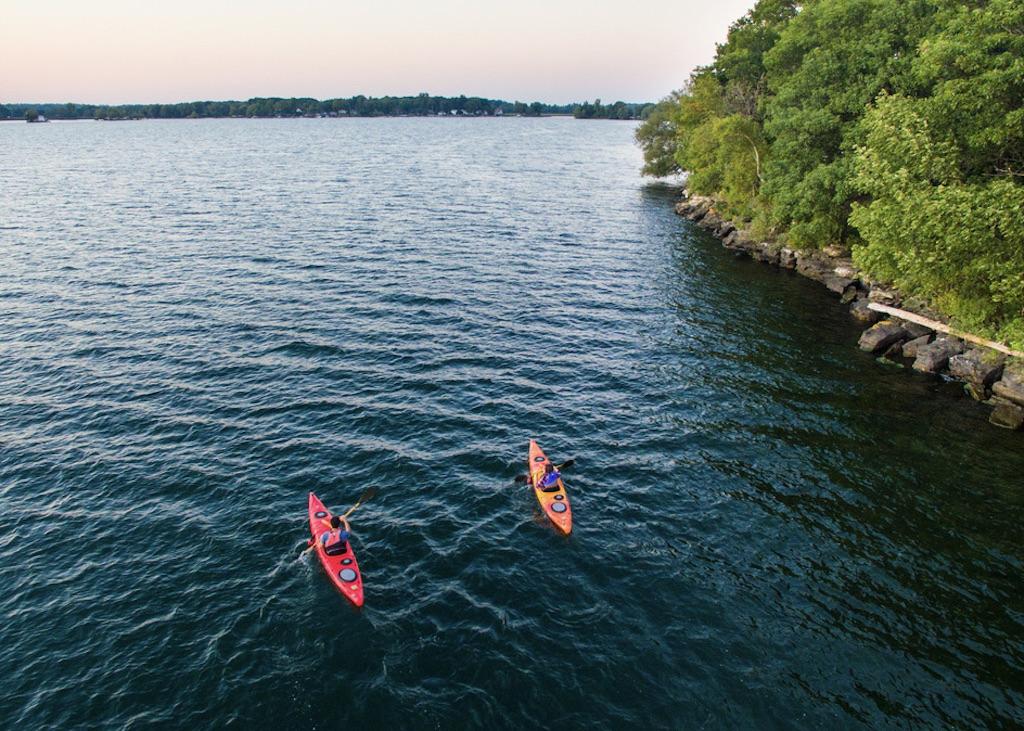
A snapping turtle hatches in the Thousand Islands National Park incubator/Parks Canada
Every May and June, some of the turtles of Thousand Islands National Park make their way to sandy road and highway shoulders to lay their eggs. Raccoons are quick to find and devour the eggs. Some remain safely hidden until September, but then scores of vulnerable hatchlings are killed crossing the road.
That’s why the park — as part of its Reptile and Amphibian Recovery and Education (R.A.R.E.) program — collects as many eggs as possible, incubates them in a private nursery in its admin complex, and releases the hatchlings back into local waterways within 10 days of their birth. It did this with close to 100 eggs during a 2019 pilot project, and with another 35 eggs in 2020 in a drop that was blamed on Covid-19 restrictions. This spring will mark the program’s third season and staff hope it will be “full steam ahead” despite the pandemic.
“In terms of an ecological win, it’s one of those long-term ones where we will see in 10 or 20 years whether the hatchlings reach adulthood and breed,” says superintendent Leslie MacPherson. But given that turtle hatchlings only have a two per cent survival rate, “we’re giving them a better chance of survival.”
The park is home to five kinds of turtles — including Blanding’s, northern map and snapping — that are a mix of endangered, threatened or of “special concern” under the Species at Risk Act.
So far, poaching isn’t a problem in the park, but it’s illegal to collect turtle eggs without a permit and the park can’t accept egg donations from the public. But it can loan turtle nest protectors to area residents who find turtles laying eggs on their property. These wood boxes are hammered into the ground and topped with mesh screens weighed down by rocks to protect the nest from predators and let the baby turtles hatch safely. Pre-Covid, park staff hosted nest protector-making parties, turtle release parties and turtle talks.

A turtle nest protector along the road in Thousand Islands National Park/Parks Canada
The park has provided almost 100 nest protectors, says MacPherson, and there are eco-fences outside the park that direct turtles to culverts to safely cross the road. The dream is to create full-fledged eco-passages (specialized wildlife tunnels) like at Bruce Peninsula National Park.
If you see a turtle crossing the road, MacPherson suggests gently helping it cross, by approaching from behind, and lifting it from its belly. She uses a car mat for a “lift and shuffle method.” The key, though, is to “always go in the direction they’re headed. Don’t turn them. Don’t decide their path.”
Established in 1904 as the first Canadian national park east of the Rockies, Thousand Islands is a cluster of granite hilltops and islands that joins northern Ontario’s Canadian Shield with New York’s Adirondack Mountains. The park is between Brockville and Kingston, about three hours east of Toronto, and includes 20-odd islands and three mainland properties on the St. Lawrence River.
“We’re old and small, but we do have a lot going on,” says MacPherson.
One of Canada’s most biologically diverse national parks, Thousand Islands attracts 10 species of snakes and lizards, five species of turtles, 10 species of frogs and toads, and six species of salamanders. Many of these species are at risk, including the gray ratsnake, one of the largest snakes in Canada and one that can only be found here and on the north shore of Lake Erie. MacPherson calls it “probably our most famous resident.”

A snapping turtle hatchling is being released into wetlands in Thousand Islands National Park/Parks Canada
The park was one of four in Ontario that shared a $6-million ($4.7-million USD) injection from the federal government last year for projects aimed at fighting climate change, restoring ecosystems and recovering species at risk. The other parks were Bruce Peninsula (which got most of the money), Fathom Five National Marine Park and Georgian Bay Islands National Park.
The Thousand Islands region, including the park, was recently declared an Important Amphibian and Reptile Area by the Canadian Herpetological Society because its dynamic range of wetlands supports rare and diverse reptile and amphibian species like the Common Five-lined Skink, Spotted Turtle and Western Chorus Frog. Habitat loss, road mortality and environmental contamination are major threats and cause many species to be threatened and endangered.
The park’s islands and riverside environments are the traditional summer home of Haudenosaunee and Mississauga Anishinaabe First Nations. Now they draw boaters who camp at park docks, campers and daytrippers who hire water taxis, and kayakers and canoers — some guided, some independent. There are 10 oTENTik tent-cabins, half on the mainland and half on the islands.
“One of our goals is to try to get more of the park accessible to all Canadians,” says MacPherson. Thousand Islands doesn’t have a Parks Canada boat shuttle like Georgian Bay Islands does, but there are private cruise companies, water taxis and kayak/canoe outfitters.

Kayakers and other boaters are drawn to Thousand Islands National Park/Parks Canada
Plants and animals are drawn by the moderating effects of the Great Lakes and the variety of micro-habitats. The islands form a land bridge from northwest to southeast across the St. Lawrence River. This narrow isthmus — the Frontenac Axis or Arch — joins the Canadian Shield and the Adirondack Mountains to form one contiguous ecosystem. While the Great Lakes can be a barrier to migrating flora and fauna, Parks Canada says “the St. Lawrence funnels the water into a narrow channel and the islands form stepping stones, shortening distances between land masses.” The Great Lakes to the west also help create a “heat sink” that moderates the climate in the area immediately surrounding the islands, and so many plants and animals reach the limits of their range here.
“We have a lot of species moving between those spaces, which is important for gene flow and preserving biodiversity,” says MacPherson.
But Thousand Islands is just south of Highway 401 and significant threats include direct human disturbance, urbanization and development pressures, sport fishing, climate change, exotic invertebrates such as zebra mussels, exotic vegetation such as purple loosestrife, heavy metals and by-product pollution, transportation and utility corridors affecting habitat connectivity, and forest habitat loss due to extraction.
The park is within the UNESCO-designated Frontenac Arch Biosphere Reserve because it has important natural and ecological values and is a place where people live, work, and enjoy economic and recreational activities based on respect for the environment.

 Support Essential Coverage of Essential Places
Support Essential Coverage of Essential Places



